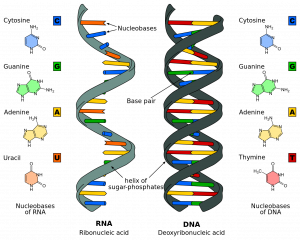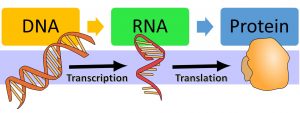Molecular Biology: From DNA to RNA to Protein
Themes from Intro Bio
Introduction
“Consider just three of Earth’s inhabitants: a bright yellow daffodil that greets the spring, the single-celled creature called Thermococcus that lives in boiling hot springs, and you. Even a science-fiction writer inventing a story set on a distant planet could hardly imagine three more different forms of life.
Yet you, Thermococcus and the daffodil are related! Indeed, all of the Earth’s billions of living things are kin to each other!”
Underlying this cellular diversity is biochemical unity. All cells contain molecules that encode information and can be copied—the nucleic acids DNA and its simpler relative, RNA.
Proteins—workhorse molecules that perform important tasks. And encapsulating them all, there’s a membrane made from fatty acids.
Below is a refresher into some themes that you encountered in earlier introductory classes. Throughout the semester we will explore these in greater detail as well as some unfamiliar but exciting new topics.
What is a Gene?
The gene is the basic physical unit of inheritance. Genes are passed from parents to offspring and contain the information needed to specify traits. Genes are arranged, one after another, on structures called chromosomes. A chromosome contains a single, long DNA molecule- only a portion of which corresponds to a single gene- as well as the structural proteins (called histones) that the DNA molecule wraps around. Humans have approximately 20,000 genes arranged on their chromosomes.
Watch the following brief video for an animated view of the relationship between chromosomes and genes.
DNA and RNA
The two main types of nucleic acids are deoxyribonucleic acid (DNA) and ribonucleic acid (RNA). As described earlier in this chapter, DNA is the genetic material in all living organisms, ranging from single-celled bacteria to multicellular mammals.
It is in the nucleus of eukaryotes and in the organelles mitochondria and chloroplasts. In prokaryotes, the DNA is not enclosed in a membranous envelope.
The cell’s entire genetic content is its genome, and the study of genomes is genomics. In eukaryotic cells but not in prokaryotes, a DNA molecule may contain tens of thousands of genes. Many genes contain information to make protein products (e.g., mRNA). Other genes code for RNA products.
DNA controls all of the cellular activities by turning the genes “on” or “off.”
The other type of nucleic acid, RNA, is mostly involved in protein synthesis. The DNA molecules never leave the nucleus but instead use an intermediary molecule to communicate with the rest of the cell.
This intermediary is the messenger RNA (mRNA).
Other types of RNA—like rRNA, tRNA, and microRNA—are involved in protein synthesis and its regulation but do carry code for proteins (they are non-coding RNAs)
DNA and RNA are comprised of monomers that scientists call nucleotides. The nucleotides combine with each other to form a polynucleotide, DNA or RNA.
Three components comprise each nucleotide: a nitrogenous base, a pentose (five-carbon) sugar, and a phosphate group. Each nitrogenous base in a nucleotide is attached to a sugar molecule, which is attached to one or more phosphate groups.
Therefore, although the terms “base” and “nucleotide” are sometimes used interchangeably, a nucleotide contains a base as well as part of the sugar-phosphate backbone.

Comparison of RNA (left molecule) and DNA (right molecule). The color of the bases in RNA and DNA aligns with the colored boxes next to each base molecule.
Exercises
Examine the image above and then answer the following questions:
Gene Expression
The mechanism for how information coded in DNA is ‘brought to life’ or ‘expressed’ into proteins is often referred to as the Central Dogma of life.
It involves 2 processes: Transcription and Translation.
Because proteins are coded by genes, the term “gene expression” refers to protein synthesis (i.e., making proteins), including the regulation of that synthesis.

Transcription the first step in gene expression results in the production of RNA. The RNA that codes for proteins is messenger RNA or mRNA.
Note: Not all RNA codes for proteins! Functional RNA – like tRNA and ribosomal RNA and others serve important roles in the regulation of gene expression!
DNA never “becomes” RNA; rather, the DNA is “read” to make an RNA copy.
In eukaryotic cells, the mRNA leaves the nucleus, and then, through the process of translation, the mRNA is read to create an amino acid sequence that folds into a protein.
Consider what the terms “transcribe” and “translate” mean in relation to language. To “transcribe” something means to rewrite text again in the same language while to “translate” something means to rewrite the text in a different language.
Similar to these meanings, in biology, DNA is transcribed into RNA: both DNA and RNA are made of nucleic acid (i.e., the same “language”). With the assistance of proteins, DNA is “read” and transcribed into an mRNA sequence.
To read RNA and create protein, though, we refer to it as being translated: RNA is made of nucleic acid, and protein is made of amino acids (i.e., different “languages”). Therefore, DNA is transcribed to create an mRNA sequence, and then the mRNA sequence is translated to make a protein.
Protein Synthesis Overview
The following is an overview of each of these processes.
Transcription
A gene is complex: it contains not only the code for the resulting protein but also several regulatory factors that determine if and when the region that codes for a protein are read to create protein.
What follows is a simplified diagram of the components of a gene that are used in transcription.
Exercise
Given a specific DNA strand, what is the sequence of the resulting mRNA molecule? We will learn about how mRNA is created in a later chapter.
Translation
Translation involves different types of RNA, and we will explain them in more detail in later chapters: rRNA, tRNA, mRNA, and microRNA.
After an mRNA is created, it leaves the nucleus and is attracted to or attracts a ribosome, which is a molecule made of rRNA and polypeptides. Then, in the ribosome, and with the assistance of tRNAs, the mRNA is read and an amino acid sequence is created.
DNA and mRNA create sequences with just four types of bases; yet, these bases code for 20 unique amino acids (the makeup of protein). How is this possible? Watch the following video to find out!
Regulation of Gene Expression
As we shall see throughout the semester, our cells resort to a number of ways and resources in controlling gene expression in space and time- what genes are expressed, when they are expressed, and how robust is the expression. Regulation may occur at any point in the expression of a gene, from the start of the transcription phase of protein synthesis to the processing of a protein after synthesis occurs.
This tightly controlled regulation is key to the development as well as the smooth functioning of an already developed organism.
Attributions
This chapter is a modified derivative of the following articles:
“Gene” by National Human Genome Research Institute, National Institutes of Health, Talking Glossary of Genetic Terms.
“Nucleic Acids” by OpenStax College, Biology 2e, CC BY 4.0. Download the original article at https://openstax.org/books/biology-2e/pages/3-5-nucleic-acids
Genetic Science Learning Center. (2017, August 1) Shared Functions, Shared Genes. Retrieved December 16, 2021, from https://learn.genetics.utah.edu/content/evolution/sharedfunctions

